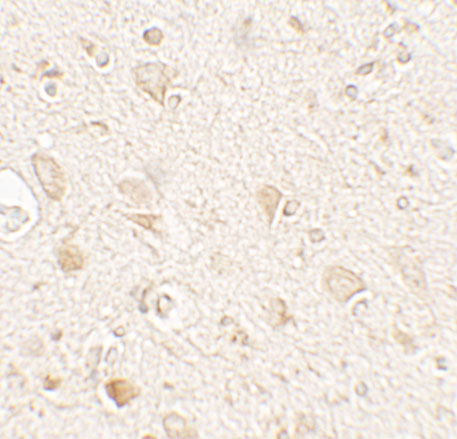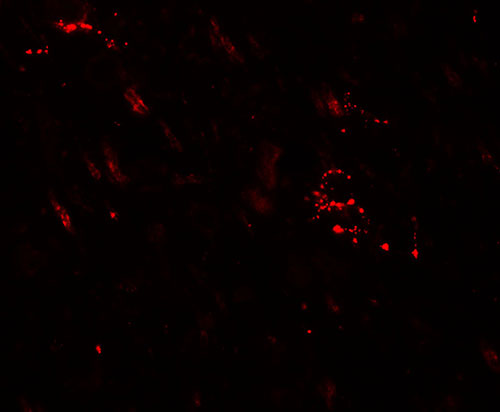MAP1LC3A Antibody
- 产品详情
- 实验流程
- 背景知识
Application
| WB, IF, E, IHC-P |
|---|---|
| Primary Accession | Q9H492 |
| Other Accession | NP_852610, 31563518 |
| Reactivity | Human |
| Host | Rabbit |
| Clonality | Polyclonal |
| Isotype | IgG |
| Calculated MW | 14272 Da |
| Concentration (mg/ml) | 1 mg/mL |
| Conjugate | Unconjugated |
| Application Notes | MAP1LC3A antibody can be used for detection of MAP1LC3A by Western blot at 1 - 2 µg/ml. Antibody can also be used for Immunohistochemistry starting at 5 µg/mL. For immunofluorescence start at 20 µg/mL. |
| Gene ID | 84557 |
|---|---|
| Other Names | Microtubule-associated proteins 1A/1B light chain 3A, Autophagy-related protein LC3 A, Autophagy-related ubiquitin-like modifier LC3 A, MAP1 light chain 3-like protein 1, MAP1A/MAP1B light chain 3 A, MAP1A/MAP1B LC3 A, Microtubule-associated protein 1 light chain 3 alpha, MAP1LC3A |
| Target/Specificity | MAP1LC3A; MAP1LC3A antibody is human specific. At least two isoforms of MAP1LC3A are known to exist. MAP1LC3A antibody is predicted to not cross-react with MAP1LC3B or MAP1LC3C. |
| Reconstitution & Storage | MAP1LC3A antibody can be stored at 4℃ for three months and -20℃, stable for up to one year. |
| Precautions | MAP1LC3A Antibody is for research use only and not for use in diagnostic or therapeutic procedures. |
| Name | MAP1LC3A |
|---|---|
| Function | Ubiquitin-like modifier involved in formation of autophagosomal vacuoles (autophagosomes) (PubMed:20713600, PubMed:24290141). While LC3s are involved in elongation of the phagophore membrane, the GABARAP/GATE-16 subfamily is essential for a later stage in autophagosome maturation (PubMed:20713600). Through its interaction with the reticulophagy receptor TEX264, participates in the remodeling of subdomains of the endoplasmic reticulum into autophagosomes upon nutrient stress, which then fuse with lysosomes for endoplasmic reticulum turnover (PubMed:31006537, PubMed:31006538). |
| Cellular Location | Cytoplasmic vesicle, autophagosome membrane; Lipid-anchor. Endomembrane system; Lipid-anchor. Cytoplasm, cytoskeleton {ECO:0000250|UniProtKB:Q91VR7}. Note=LC3-II binds to the autophagic membranes. |
| Tissue Location | Most abundant in heart, brain, liver, skeletal muscle and testis but absent in thymus and peripheral blood leukocytes |
For Research Use Only. Not For Use In Diagnostic Procedures.
Provided below are standard protocols that you may find useful for product applications.
BACKGROUND
Microtubule-associated proteins (MAPs) regulate microtubule stability and play critical roles in neuronal development and plasticity (1). MAP1LC3A belongs to the MAP1 LC3 family of proteins that form mature complexes with MAP1A and MAP1B which are thought to be important in the formation and development of axons and dendrites (2). MAP1LC3A is one of three isoforms of MAP1LC3, the mammalian homolog of yeast ATG8, an essential autophagy protein. These isoforms exhibit distinct expression patterns and MAP1LC3A, like MAP1LC3A but not MAP1LC3B, is post-translationally modified, suggesting the three isoforms may have different physiological functions (3).
REFERENCES
Mandelkow E and Mandelkow EM. Microtubules and microtubule-associated proteins. Curr. Opin. Cell Biol. 1995; 7:72-81.
Halpain S and Dehmelt L. The MAP1 family of microtubule-associated proteins. Genome Biol. 2006; 7:224.
He H, Dang Y, Dai F, et al. Post-translational modifications of three members of the human MAP1LC3 family and detection of a novel type of modification for MAP1LC3B. J. Biol. Chem. 2003; 278:29278-87.
终于等到您。ABCEPTA(百远生物)抗体产品。
点击下方“我要评价 ”按钮提交您的反馈信息,您的反馈和评价是我们最宝贵的财富之一,
我们将在1-3个工作日内处理您的反馈信息。
如有疑问,联系:0512-88856768 tech-china@abcepta.com.























 癌症的基本特征包括细胞增殖、血管生成、迁移、凋亡逃避机制和细胞永生等。找到癌症发生过程中这些通路的关键标记物和对应的抗体用于检测至关重要。
癌症的基本特征包括细胞增殖、血管生成、迁移、凋亡逃避机制和细胞永生等。找到癌症发生过程中这些通路的关键标记物和对应的抗体用于检测至关重要。 为您推荐一个泛素化位点预测神器——泛素化分析工具,可以为您的蛋白的泛素化位点作出预测和评分。
为您推荐一个泛素化位点预测神器——泛素化分析工具,可以为您的蛋白的泛素化位点作出预测和评分。 细胞自噬受体图形绘图工具为你的蛋白的细胞受体结合位点作出预测和评分,识别结合到自噬通路中的蛋白是非常重要的,便于让我们理解自噬在正常生理、病理过程中的作用,如发育、细胞分化、神经退化性疾病、压力条件下、感染和癌症。
细胞自噬受体图形绘图工具为你的蛋白的细胞受体结合位点作出预测和评分,识别结合到自噬通路中的蛋白是非常重要的,便于让我们理解自噬在正常生理、病理过程中的作用,如发育、细胞分化、神经退化性疾病、压力条件下、感染和癌症。








